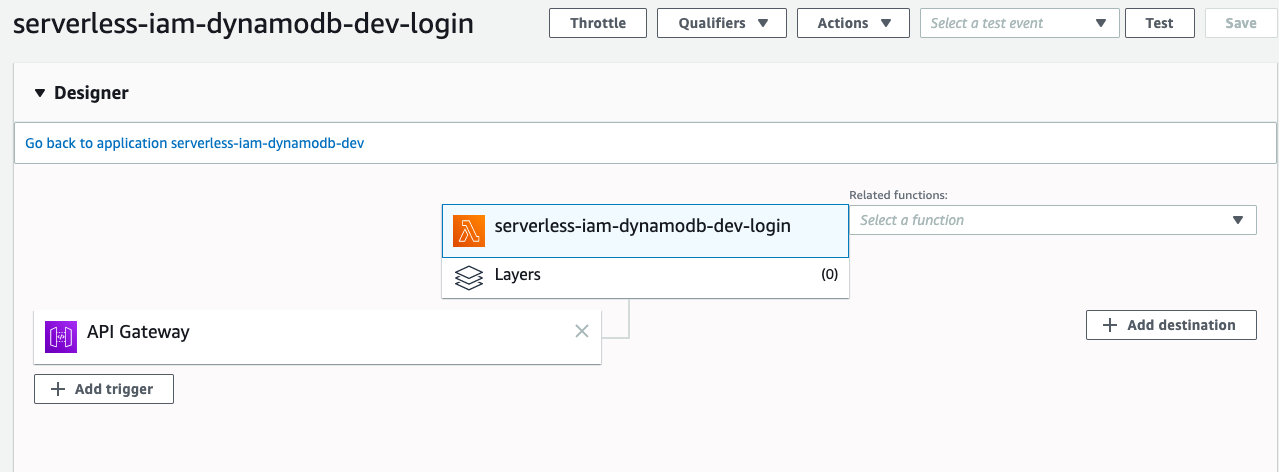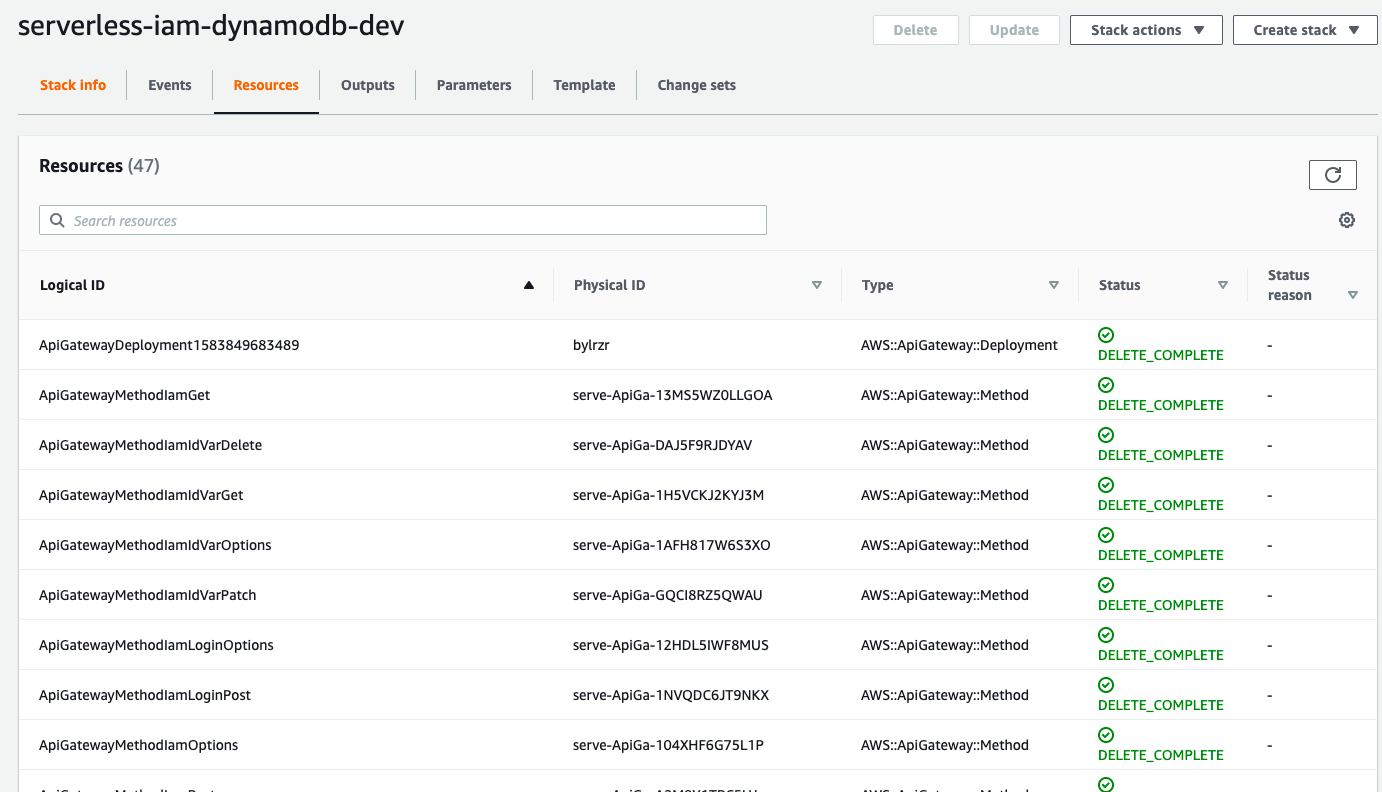Thursday, 26 March 2020
Building Serverless CRUD services in Go with DynamoDB - Part 6 (Bonus)
Welcome to the part 6. This is the last part of this series. In this post, we will create ``loginHandler.go``.
# Getting started
First, let's add the config under functions in serverless.yml
```
login:
handler: bin/handlers/loginHandler
package:
include:
- ./bin/handlers/loginHandler
events:
- http:
path: iam/login
method: post
cors: true
```
Create a file ``loginHandler.go`` under src/handlers
Similarly, we have the below structure.
```
package main
import (
"context"
"encoding/json"
"fmt"
"os"
"github.com/aws/aws-lambda-go/events"
"github.com/aws/aws-lambda-go/lambda"
"github.com/aws/aws-sdk-go/aws"
"github.com/aws/aws-sdk-go/aws/session"
"github.com/aws/aws-sdk-go/service/dynamodb"
"github.com/aws/aws-sdk-go/service/dynamodb/dynamodbattribute"
utils "../utils"
)
type Credentials struct {
// TODO1
}
type User struct {
ID string `json:"id,omitempty"`
UserName string `json:"user_name,omitempty"`
FirstName string `json:"first_name,omitempty"`
LastName string `json:"last_name,omitempty"`
Age int `json:"age,omitempty"`
Phone string `json:"phone,omitempty"`
Password string `json:"password,omitempty"`
Email string `json:"email,omitempty"`
Role string `json:"role,omitempty"`
IsActive bool `json:"is_active,omitempty"`
CreatedAt string `json:"created_at,omitempty"`
ModifiedAt string `json:"modified_at,omitempty"`
DeactivatedAt string `json:"deactivated_at,omitempty"`
}
type Response struct {
Response User `json:"response"`
}
var svc *dynamodb.DynamoDB
func init() {
region := os.Getenv("AWS_REGION")
// Initialize a session
if session, err := session.NewSession(&aws.Config{
Region: ®ion,
}); err != nil {
fmt.Println(fmt.Sprintf("Failed to initialize a session to AWS: %s", err.Error()))
} else {
// Create DynamoDB client
svc = dynamodb.New(session)
}
}
func Login(ctx context.Context, request events.APIGatewayProxyRequest) (events.APIGatewayProxyResponse, error) {
var (
tableName = aws.String(os.Getenv("IAM_TABLE_NAME"))
)
//TODO2
}
func main() {
lambda.Start(Login)
}
```
Basically we are going to make an API with POST method. Users are expected to pass their credentials to ``iam/login`` to authorise their identities.
In this tutorials, we only send username and password. You may change username to email if you want. Let's update the below code and remove the comment ``// TODO1``.
```
type Credentials struct {
UserName string `json:"user_name"`
Password string `json:"password"`
}
```
As we only need to return a single object, we can use same response struct used in ``getHandler.go``
```
type Response struct {
Response User `json:"response"`
}
```
The next step is to write our logic under ``//TODO2``. The general idea is that users send their credentials which are further used to check the data in Amazon DynamoDB. It then returns the user object if it matches.
First, we need to initialise ``Credentials`` to hold our users input.
```
creds := &Credentials{}
```
Like what we did previously, parse the request body to creds
```
json.Unmarshal([]byte(request.Body), creds)
```
The next step is to utilise Query API operation for Amazon DynamoDB. In this tutorial, it finds items based on primary key values. You can also query any table or secondary index which has a composite primary key.
Query takes QueryInput. It should includes ``TableName``, ``IndexName``, ``KeyConditions``.
``TableName`` is a required field which tells the client service which table you want to perform Query.
``IndexName`` is the name of an index to query. It can be local secondary index or global secondary index on the table.
``KeyConditions`` includes ``Condition`` which is used when querying a table or an index with comparison operators such as EQ | LE | LT | GE | GT | BEGINS_WITH | BETWEEN. It can also apply ``QueryFilter``.
```
result, err := svc.Query(&dynamodb.QueryInput{
TableName: tableName,
IndexName: aws.String("IAM_GSI"),
KeyConditions: map[string]*dynamodb.Condition{
"user_name": {
ComparisonOperator: aws.String("EQ"),
AttributeValueList: []*dynamodb.AttributeValue{
{
S: aws.String(creds.UserName),
},
},
},
},
})
```
Like other handler, we retrieve the value of IAM_TABLE_NAME in our configuration file and set it to tableName.
```
tableName = aws.String(os.Getenv("IAM_TABLE_NAME"))
```
We select ``IAM_GSI`` to query, which is also defined in serverless.yml in part 1.
```
GlobalSecondaryIndexes:
- IndexName: IAM_GSI
KeySchema:
- AttributeName: user_name
KeyType: HASH
Projection:
ProjectionType: ALL
ProvisionedThroughput:
ReadCapacityUnits: 5
WriteCapacityUnits: 5
```
We then define a ``dynamodb.Condition`` struct holding our condition. As you can see, we only have one condition which is to check if ``user_name`` and ``creds.UserName`` are equal (EQ).
Check if there is an error
```
if err != nil {
fmt.Println("Got error calling Query:")
fmt.Println(err.Error())
// Status Internal Server Error
return events.APIGatewayProxyResponse{
Body: err.Error(),
StatusCode: 500,
}, nil
}
```
If there is no error, we can see a User object in ``result.Items``. However, if there is no item returned from Amazon DynamoDB, we can return an empty object in response.
```
user := User{}
if len(result.Items) == 0 {
body, _ := json.Marshal(&Response{
Response: user,
})
// Status OK
return events.APIGatewayProxyResponse{
Body: string(body),
StatusCode: 200,
}, nil
}
```
The response should look like this
```json
{
"response": {}
}
```
If there is a record found, we can pass it to user.
```
if err := dynamodbattribute.UnmarshalMap(result.Items[0], &user); err != nil {
fmt.Println("Got error unmarshalling:")
fmt.Println(err.Error())
return events.APIGatewayProxyResponse{
Body: err.Error(),
StatusCode: 500,
}, nil
}
```
Now we only check if the password in user input matches with the one in the record.
Remember we've created ``utils/password.go`` in Part 1? We've only created ``HashPassword``. We use this function to hash the password. In order to compare a bcrypt hashed password with its possible plaintext equivalent, we need another function here.
```
func CheckPasswordHash(password, hash string) bool {
err := bcrypt.CompareHashAndPassword([]byte(hash), []byte(password))
return err == nil
}
```
It's simple. We also use bcrypt to perform checking by using ``CompareHashAndPassword``.
Back to ``loginHandler.go``
```
match := utils.CheckPasswordHash(creds.Password, user.Password)
```
If it matches, then we can return user to Response.
```
if match {
body, _ := json.Marshal(&Response{
Response: user,
})
// Status OK
return events.APIGatewayProxyResponse{
Body: string(body),
StatusCode: 200,
}, nil
}
```
If not, we just return an empty user
```
body, _ := json.Marshal(&Response{
Response: User{},
})
// Status Unauthorized
return events.APIGatewayProxyResponse{
Body: string(body),
StatusCode: 401,
}, nil
```
Run the below command to deploy our code
```
./scripts/deploy.sh
```
# Testing
If you go to AWS Lambda Console, you will see there is a function called ``serverless-iam-dynamodb-dev-login``

Go to API Gateway Console to test it,
```json
{
"user_name": "wingkwong",
"password": "password"
}
```
You should see the corresponding data.
```json
{
"response": {
"id": "6405bc74-a706-4987-86a9-82cf69d386c2",
"user_name": "wingkwong",
"password": "$2a$15$abtf69CeWZwGPJxIS/D/teXV26kBfY3SmHFNSNTbhP8gNa1OUeoiy",
"email": "wingkwong.me@gmail.com",
"role": "user",
"is_active": true,
"created_at": "2020-03-07 07:29:23.336349405 +0000 UTC m=+0.087254950",
"modified_at": "2020-03-07 07:30:47.531266176 +0000 UTC m=+0.088812866"
}
}
```
Let's try a wrong password
```json
{
"user_name": "wingkwong",
"password": "password2"
}
```
You should see an empty object
```json
{
"response": {}
}
```
# Cleanup
As mentioned in Part 1, serverless provisions / updates a single CloudFormation stack every time we deploy. To cleanup, we just need to delete the stack.

Click Delete stack

You should see the status is now DELETE_IN_PROGRESS.

Once it's done, you should see the stack has been deleted.

# Source Code
{% github go-serverless/serverless-iam-dynamodb %}
Subscribe to:
Post Comments (Atom)
A Fun Problem - Math
# Problem Statement JATC's math teacher always gives the class some interesting math problems so that they don't get bored. Today t...
-
SHA stands for Secure Hashing Algorithm and 2 is just a version number. SHA-2 revises the construction and the big-length of the signature f...
-
## SQRT Decomposition Square Root Decomposition is an technique optimizating common operations in time complexity O(sqrt(N)). The idea of t...
No comments:
Post a Comment